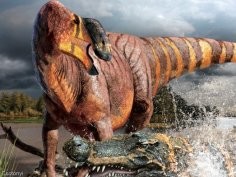
Rhinorex condrupus is a dinosaur that owes its name to the profile, and specifically wydatnemu nose (lat. Rhinorex translates as king-nose).
Herbivorous Rs. condrupus live approx. 75 million years ago in what is now Utah. He was a close relative of the other Cretaceous hadrozaurów, for example. Parazaurolofów or edmontozaura.
Terry Gates, an employee of the North Carolina State University and the Museum of Natural History of North Carolina, and his colleague Rodney Sheetz Museum of Paleontology Brigham Young came across a fossil in BYU magazine. In the 90s it was discovered in the formation Neslena, namely the Book Cliffs in Utah. Before gentlemen reconstructed skull and figured out that they are dealing with a new species, mainly dealt with perfectly preserved imprints of the skin (in 1999. Appeared large on them.)
We had almost the entire skull and it was great, but the formulation has proved extremely difficult. For 2 years wydobywaliśmy fossil sandstone, which stuck – it was like digging dinosaur skull from the concrete driveway – says Gates.
Based on the recovered bones paleontologist estimates that Rs. condrupus was approx. 9 m in length and weighing more than 3.8 tonnes. marshy He lived around the mouth of the river, approx. 80 km from the sea.
We found other hadrosaurs from the same period , but they were located approx. 200 miles [approx. 322 km] to the south and lived in different environment. The discovery gives us a geographical overview of the situation in the Cretaceous, and helps put the then species at the right time and place. [What is important] Rhinorex allows you to fill gaps in the phylogenetic tree hadrozaurów .
Gates added that he still hard to tell what Rs. condrupus was needed so a big nose. Probably had nothing to do with a better smell, but it served to lure partners recognize members of their own species or operated as a regular addition to the beak used for crushing plants.
No comments:
Post a Comment